Статьи журнала - International Journal of Image, Graphics and Signal Processing
Все статьи: 1056
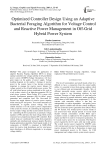
Статья научная
This paper investigates the application of adaptive Bacteria Forging Algorithm (BFA) to design optimal controllers for voltage stability of off-grid hybrid power system (OGHPS).Voltage fluctuations will have great impact on the quality of power supply. Voltage rise/drop depends on the surplus / shortage of reactive power in the system, hence it has become extremely important to manage the reactive power balance for voltage control in the off-grid hybrid power system. The off -grid hybrid power system considered in this work as a test system, consist of an Induction generator (IG) for wind power systems, Photo-Voltaic (PV) system with inverter, Synchronous generator (SG) for diesel power generation and composite load. The Over-rated PV inverter has ample amount of reactive power capacity while sourcing PV real power. Two control structures are incorporated, to regulate system voltage. The first control structure is for the reactive power compensation of the system by inverter, by controlling the magnitude of inverter output voltage and the second control structure is for controlling the SG excitation by an automatic voltage regulator (AVR) and hence the load voltage. Both control structures have proportional-integral (PI) controller. Both control loops are coordinated by tuning their parameters optimally and simultaneously using an adaptive Bacterial forging optimization algorithm. Small signal model of all components of OGHPS is simulated in SIMULINK, tested for reactive load disturbance and /or wind power input disturbance of different magnitudes to investigate voltage stability.
Бесплатно
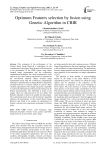
Optimum Features selection by fusion using Genetic Algorithm in CBIR
Статья научная
The evaluation of the performance of the Content Based Image Retrieval is undertaken for the consideration in this paper. Here the point of the discussion is the performance of the CBIR system using object oriented image segmentation and the evolutionary computational technique. The visual characteristics of the objects such as color, intensity and texture are extracted by the conventional methods. Object oriented image segmentation along with the evolutionary computational technique is proposed here for Image Retrieval Algorithm. Unsupervised Curve evolution method is used for object oriented segmentation of the Image and genetic Algorithm is used for the Optimum Classification and reduction in the Feature dimensionality. The Algorithm is tested on the images which are characterized by the low depth. The Berkeley database is found to be suitable for this purpose. The experimental result shows that the Genetic Algorithm enhances the performance of this Content Based Image Retrieval and found to be suitable for optimization of features selection and compression technique for Feature space.
Бесплатно
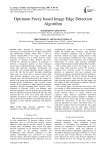
Optimum Fuzzy based Image Edge Detection Algorithm
Статья научная
Edge detection is important in image processing to aid operations such as object classification and identification amongst others. This is soley to improve interpretability of the image. Common edge detection techniques such as Sobel, Prewittt, Canny, Laplacian of Gaussian (LOG), Robertss and Zero-Crossing has attracted the attention of researchers to perform a comparative analysis on these techniques excepts fuzzy, using different type of images. Fuzzy logic based edge detection algorithms development and comparison with existing algorithm became important due to the fact that the pixels’ boundaries identifying image degs are crystal clear as expected, hence other edge detection algorithms using crisp values will be omitting some vital information pixels, this impairs the quality of the image edge detected and further application through proper interpretation. This research further extends the investigation of edge detection techniques optimality, through comparing Sobel, Prewittt, Canny, Laplacian of Gaussian (LOG), and Robertss edge detection algorithms with our proposed fuzzy based edge detection algorithm designed using MATLAB. The result indicated that the novel fuzzy based edge detection algorithm developed in this research outperforms the Canny, Sobel, Prewittt, Robertss and LOG edge detection algorithms in three different experiments with different images
Бесплатно
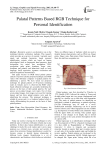
Palatal Patterns Based RGB Technique for Personal Identification
Статья научная
Biometric system is an alternative way to the traditional identity verification methods. This research article provides an overview of recently / currently used single and multiple biometrics based personal identification systems which are based on human physiological (such as fingerprint, hand geometry, head recognition, iris, retina, face recognition, DNA recognition, palm prints, heartbeat, finger veins, footprints and palates) and behavioral (such as body language, facial expression, signature verification and speech recognition) characteristics. This paper focuses on RGB based palatal pattern analysis of persons and the proposed technique uses RGB values with silhouette computes of palatal patterns for identifying a person. We have tested our proposed technique for palatal patterns of 50 persons including males & females and it is observed that RGB values based silhouette technique are accurately identifying the persons on the basis of their palatal patterns. For each person seven palatal images were taken. Out of these seven palatal images, four images were used for training dataset and last three palatal patterns were used for identifying the persons. The proposed technique is reliable & secure and it is a foolproof method which is clearly differentiating the persons on the basis of their palatal patterns.
Бесплатно
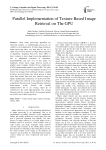
Parallel Implementation of Texture Based Image Retrieval on The GPU
Статья научная
Most image processing algorithms are inherently parallel, so multithreading processors are suitable in such applications. In huge image databases, image processing takes very long time for run on a single core processor because of single thread execution of algorithms. Graphical Processors Units (GPU) is more common in most image processing applications due to multithread execution of algorithms, programmability and low cost. In this paper we implement texture based image retrieval system in parallel using Compute Unified Device Architecture (CUDA) programming model to run on GPU. The main goal of this research work is to parallelize the process of texture based image retrieval through entropy, standard deviation, and local range, also whole process is much faster than normal. Our work uses extensive usage of highly multithreaded architecture of multi-cored GPU. We evaluated the retrieval of the proposed technique using Recall, Precision, and Average Precision measures. Experimental results showed that parallel implementation led to an average speed up of 140.046×over the serial implementation. The average Precision and the average Recall of presented method are 39.67% and 55.00% respectively.
Бесплатно
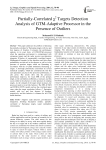
Статья научная
This paper addresses the problem of detecting the partially-correlated χ2 fluctuating targets with two and four degrees of freedom. It presents the performance analysis, in its exact form, of GTM-CFAR processor when the operating environment is contaminated with extraneous targets and the radar receiver post-detection integrates M pulses of exponentially correlated targets. Mathematical formulas for the detection and false alarm probabilities are derived, in the absence as well as in the presence of spurious targets which are fluctuating in accordance with the so-called moderately fluctuating χ2 targets. A thorough performance assessment by several numerical examples, which has considered the role that each parameter can play in the processor performance, is also given. The results show that the processor performance improves, for weak SNR of the primary target, as the correlation coefficient ρs increases and this occurs either in the absence or in the presence of outlying targets. As the strength of the target return increases, the processor tends to invert this behavior. The SWI & SWII and SWIII & SWIV models enclose the correlated target cases when the target correlation follows χ2 fluctuation models with two and four degrees of freedom, respectively, and this behavior is common for all GTM based detectors.
Бесплатно
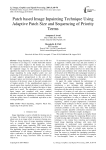
Patch based image inpainting technique using adaptive patch size and sequencing of priority terms
Статья научная
Image Inpainting is a system used to fill lost information in an image in a visually believable manner so that it seems original to the human eye. Several algorithms are developed in the past which tend to blur the inpainted image. In this paper, we present an algorithm that improves the performance of patch based image inpainting by using adaptive patch size and sequencing of the priority terms. The patch width (wxw) is made adaptive (proportional) to the area of the damaged region and inversely proportional to standard deviation of the known values in the patch around point of highest priority. If the neighbourhood region is a smooth region then standard deviation is small therefore large patch size is used and if standard deviation is large patch size is small. The algorithm is tested for various input images and compared with some standard algorithm to evaluate its performance. Results show that the time required for inpainting is drastically reduced while the quality factor is maintained equivalent to the existing techniques.
Бесплатно
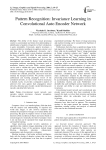
Pattern Recognition: Invariance Learning in Convolutional Auto Encoder Network
Статья научная
The ability of the human visual processing system to accommodate and retain clear understanding or identification of patterns irrespective of their orientations is quite remarkable. Conversely, pattern invariance, a common problem in intelligent recognition systems is not one that can be overemphasized; obviously, one's definition of an intelligent system broadens considering the large variability with which the same patterns can occur. This research investigates and reviews the performance of convolutional networks, and its variant, convolutional auto encoder networks when tasked with recognition problems considering invariances such as translation, rotation, and scale. While, various patterns can be used to validate this query, handwritten Yoruba vowel characters have been used in this research. Databases of images containing patterns with constraints of interest are collected, processed, and used to train and simulate the designed networks. We provide extensive architectural and learning paradigms review of the considered networks, in view of how built-in invariance is learned. Lastly, we provide a comparative analysis of achieved error rates against back propagation neural networks, denoising auto encoder, stacked denoising auto encoder, and deep belief network.
Бесплатно
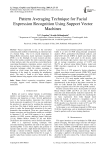
Pattern averaging technique for facial expression recognition using support vector machines
Статья научная
Facial expression is one of the nonverbal communication methods of identifying an emotional state of a human being. Due to its crucial importance in Human-Robot interaction, facial expression recognition (FER) is in the limelight of recent research activities. Most of the studies consider the whole expression images in their analysis, and it has several has several drawbacks concerning illumination, orientation, texture, zoom level, time and space complexity. In this paper, a novel feature extraction technique called the pattern averaging is studied on whole image data using reduction in the dimension of the image by averaging the neighboring pixels. The study is found to give better results on standard datasets using support vector machine classifier.
Бесплатно
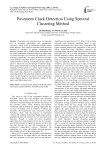
Pavement Crack Detection Using Spectral Clustering Method
Статья научная
Pavement crack detection plays an important role in pavement maintaining and management, nowadays, which could be performed through remote image analysis. Thus, edges of pavement crack should be extracted in advance; in general, traditional edge detection methods don’t consider phase information and the spatial relationship between the adjacent image areas to extract the edges. To overcome the deficiency of the traditional approaches, this paper proposes a pavement crack detection algorithm based on spectral clustering method. Firstly, a measure of similarity between pairs of pixels is taken into account through orientation energy. Then, spatial relationship is needed to find regions where similarity between pixels in a given region is high and similarity between pixels in different regions is low. After that, crack edge detection is completed with spectral clustering method. The presented method has been run on some real life images of pavement crack, experimental results display that the crack detection method of this paper could obtain ideal result.
Бесплатно

Pedestrian Detection in Thermal Images Using Deep Saliency Map and Instance Segmentation
Статья научная
Pedestrian detection is an established instance of computer vision task. Pedestrian detection from the color images has achieved robust performance but in the night time or in bad light conditions it has low detection accuracy. Thermal images are used for detecting people at night time, foggy weather or in bad lighting situations when color images have a lower vision. But in the daytime where the surroundings are warm or warmer than pedestrians then the thermal image has lower accuracy. Hence thermal and color image pair can be a solution but it is expensive to capture color-thermal pair and misaligned imagery can cause low detection accuracy. We proposed a network that achieved better accuracy by extending the prior works which introduced the use of the saliency map in pedestrian detection tasks from the thermal images into instance-level segmentation. We worked on a subdivision of KAIST Multispectral Pedestrian Detection Dataset [8] which has pixel-level annotations. We have trained Mask-RCNN for pedestrian detection task and report the added effect of saliency maps generated using PiCA-Net. We have achieved an accuracy of 88.14% over day and 91.84% over night images. So, our model has reduced the miss rate by 24.1% and 23% over the existing state-of-the-art method in day and night images.
Бесплатно
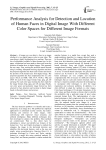
Статья научная
A human eye can detect a face in an image whether it is in a digital image or also in some video. The same thing is highly challenging for a machine. There are lots of algorithms available to detect human face. In this paper, a technique has been made to detect and locate the position of human faces in digital images. This approach has two steps. First, training the artificial neural network using Levenberg–Marquardt training algorithm and then the proposed algorithm has been used to detect and locate the position of the human faces from digital image. The proposed algorithm has been implemented for six color spaces which are RGB, YES, YUV, YCbCr, YIQ and CMY for each of the image formats bmp, jpeg, gif, tiff and png. For each color space training has been made for the image formats bmp, jpeg, gif, tiff and png. Finally, one color space and particular image format has been selected for face detection and location in digital image based on the performance and accuracy.
Бесплатно
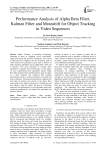
Статья научная
Object Tracking is becoming increasingly important in areas of computer vision, surveillance, image processing and artificial intelligence. The advent of high powered computers and the increasing need of video analysis has generated a great deal of interest in object tracking algorithms and its applications. This said it becomes even more important to evaluate these algorithms to quantify their performance. In this paper, we have implemented three algorithms namely Alpha Beta filter, Kalman filter and Meanshift to track an object in a video sequence and compared their tracking performance based on various parameters in normal and noisy conditions. The proposed parameters employed are error plots in position and velocity of the object, Root mean square error, object tracking error, tracking rate and time taken to track the object. The goal is to illustrate practically the performance of each algorithm under such conditions quantitatively and identify the algorithm that performs the best.
Бесплатно
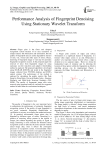
Performance Analysis of Fingerprint Denoising Using Stationary Wavelet Transform
Статья научная
Finger print is the finest and cheapest recognition system because of its easy extraction of unique features like bifurcation and termination. But the quality of fingerprint data are easily degraded by dryness of skin, wet, wound and other types of noises. Hence, denoising of fingerprint image is vital step for automatic fingerprint recognition system. In the proposed paper the removal of noise from fingerprint images by using stationary wavelet transform and adaptive thresholding method is analysed. The proposed algorithm is developed using MATLAB (R2010b) and tested in the fingerprint images collected from FVC2004 database and R303A optical scanner. The performance of the method is analysed by calculating the quality metrics like Peak Signal to Noise Ratio, Universal Quality Index , Structure Similarity and Multi-Scale Structure Similarity (MS-SSIM). The quality of fingerprint image after noise removal using proposed analysis confirms the suggested method is better than the conventional techniques.
Бесплатно
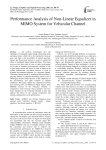
Performance Analysis of Non-Linear Equalizer in MIMO System for Vehicular Channel
Статья научная
All wireless technologies face the challenges of multipath signal fading, attenuation delay and phase delay which led to the interference between users and there is the possibility of limited spectrum. Linear and Non-Linear receiver is used to combat the effect of multipath signal fading and delay. The linear receiver gives best result in case of static environment but in case of dynamic environmental condition it fails to give better results and hence in order to improve the system performance non-linear receiver is used in dynamic environment condition. As a dynamic channel, Vehicular Channel model is considered because there is growing interest in vehicular networking and it is also a challenging channel model because of the complexity of the environment, and rapid variation in channel conditions. This paper studies the comparison between Zero Forcing (ZF) and Minimum Mean Square Error (MMSE) receiver in the Vehicular Channel. A comparative study between linear equalizer and non-linear equalizer in the Vehicular Channel is done and analyze the effect of the varying modulation and antenna configuration on the performance.
Бесплатно

Performance Analysis of Texture Image Classification Using Wavelet Feature
Статья научная
This paper compares the performance of various classifiers for multi class image classification. Where the features are extracted by the proposed algorithm in using Haar wavelet coefficient. The wavelet features are extracted from original texture images and corresponding complementary images. As it is really very difficult to decide which classifier would show better performance for multi class image classification. Hence, this work is an analytical study of performance of various classifiers for the single multiclass classification problem. In this work fifteen textures are taken for classification using Feed Forward Neural Network, Naïve Bays Classifier, K-nearest neighbor Classifier and Cascaded Neural Network.
Бесплатно
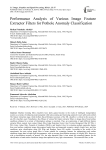
Performance Analysis of Various Image Feature Extractor Filters for Pothole Anomaly Classification
Статья научная
Machine learning (ML) classifiers have lately gained traction in the realm of intelligent transportation systems as a means of enhancing road navigation while also assisting and increasing automotive user safety and comfort. The feature extraction stage, which defines the performance accuracy of the ML classifier, is critical to the success of any ML classifiers used. Nonetheless, the efficacy of various ML feature extractor filters on image data of road surface conditions obtained in a variety of illumination settings is uncertain. Thus, an examination of eight different feature extractor filters, namely Auto colour, Binary filter, Edge Detection, Fuzzy Color Texture Histogram Filter (FCTH), J-PEG Color, Gabor filter, Pyramid of Gradients (PHOG), and Simple Color, for extracting pothole anomalies feature from road surface conditions image data acquired under three environmental scenarios, namely bright, hazy, and dim conditions, prior classification using J48, JRip, and Random Forest ML models. According to the results of the experiments, the auto colour image filter is better suitable for extracting features for categorizing road surface conditions image data in bright light circumstances, with an average classification accuracy of roughly 96%. However, with a classification accuracy of around 74%, the edge detection filter is best suited for extracting features for the classification of road surface conditions image data captured in hazy light circumstances. The autocolor filter, on the other hand, has an accuracy of roughly 87% when it comes to classifying potholes in low-light conditions. These findings are crucial in the selection of feature extraction filters for use by ML classifiers in the development of a robust autonomous pothole detection and classification system for improved navigation on anomalous roads and possible integration into self-driving cars.
Бесплатно
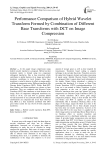
Статья научная
In this paper image compression using hybrid wavelet transform is proposed. Hybrid wavelet transform matrix is formed using two component orthogonal transforms. One is base transform which contributes to global features of an image and another transform contributes to local features. Here base transform is varied to observe its effect on image quality at different compression ratios. Different transforms like Discrete Kekre Transform (DKT), Walsh, Real-DFT, Sine, Hartley and Slant transform are chosen as base transforms. They are combined with Discrete Cosine Transform (DCT) that contributes to local features of an image. Sizes of component orthogonal transforms are varied as 16-16, 32-8 and 64-4 to generate hybrid wavelet transform of size 256x256. Results of different combinations are compared and it has been observed that, DKT as a base transform combined with DCT gives better results for size 16x16 of both component transforms.
Бесплатно
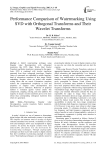
Статья научная
A hybrid watermarking technique using Singular value Decomposition with orthogonal transforms like DCT, Haar, Walsh, Real Fourier Transform and Kekre transform is proposed in this paper. Later, SVD is combined with wavelet transforms generated from these orthogonal transforms. Singular values of watermark are embedded in middle frequency band of column/row transform of host image. Before embedding, Singular values are scaled with suitable scaling factor and are sorted. Column/row transform reduces the computational complexity to half and properties of singular value decomposition and transforms add to robustness. Behaviour of proposed method is evaluated against various attacks like compression, cropping, resizing, and noise addition. For majority of attacks wavelet transforms prove to be more robust than corresponding orthogonal transform from which it is generated.
Бесплатно

Performance Evaluation and Comparative Analysis of Different Filters for Noise Reduction
Статья научная
The quality of microscopic images is generally degraded during the image acquisition by quantizing noise, electrical noise, light illumination etc. Noise reduction is considered as a very important preprocessing step as the quality of the images can determine the accuracy of the results. The work done focuses on the noise reduction using different filters on the different types of noises applied on the common digital images and specifically the Leukemia images. 40 images were taken for the comparison purpose; 20 digital images and 20 Leukemia images of different types of Leukemia. The qualitative as well as quantitative analysis of the performance of the filters on the different noises is done. For the quantitative analysis the parameters used for the evaluation of the images are MSE, PSNR and CoC. For the qualitative analysis visual analysis in terms of quality is also done using the resultant images and their histograms. Simulation has been done in Matlab 11b. From the test cases it has been observed that Adaptive Filter produces good results on Salt and Pepper, Speckle and Gaussian noise in case of the digital images. Whereas in case of Leukemia images results of Median Filter are best for the Gaussian, Poisson and Speckle noise corrupted images.
Бесплатно

